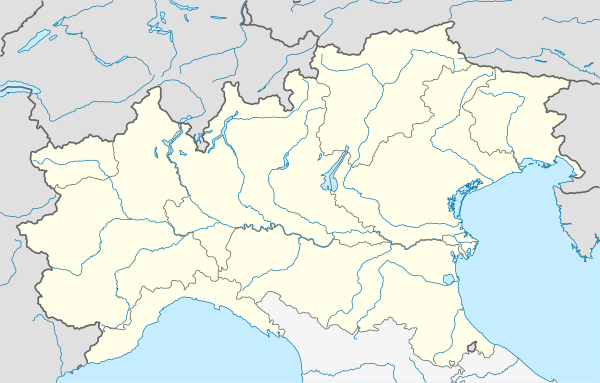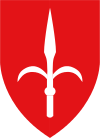Trieste Centrale railway station
Trieste Centrale | |
|---|---|
|
The main entrance | |
| Location |
Piazza della Libertà 34132 Trieste TS Trieste, Trieste, Friuli-Venezia Giulia Italy |
| Coordinates | 45°39′27″N 13°46′20″E / 45.657470°N 13.772105°ECoordinates: 45°39′27″N 13°46′20″E / 45.657470°N 13.772105°E |
| Operated by |
Rete Ferroviaria Italiana Centostazioni |
| Line(s) |
Venice–Trieste Udine–Trieste Vienna–Trieste |
| Train operators | Trenitalia |
| Connections |
|
| Other information | |
| Classification | Gold |
| History | |
| Opened | 27 July 1857 |
| Location | |
 Trieste Centrale Location within Northern Italy | |
Trieste Centrale railway station (Italian: Stazione di Trieste Centrale; German: Triest Südbahnhof (former name) is the main station serving the city and municipality (comune) of Trieste, in the autonomous region of Friuli-Venezia Giulia, northeastern Italy.
Opened in 1857, the station is a terminus for direct lines to Venice, Udine and Vienna, and for the belt line leading to Trieste's marshalling yard, near the now closed Trieste Campo Marzio railway station.[1]
Trieste Centrale is currently managed by Rete Ferroviaria Italiana (RFI). However, the commercial area of the passenger building is managed by Centostazioni. Train services to and from the station are operated by Trenitalia. Each of these companies is a subsidiary of Ferrovie dello Stato (FS), Italy's state-owned rail company.
Location
Trieste Centrale railway station is situated at Piazza della Libertà, north of the city centre. It is at the western end of the Borgo Teresiano[2] district, adjacent to the old free port of Trieste.
History
The present day rail network of the city of Trieste is based, for the most part, upon railway lines constructed by the former Austrian and Austro-Hungarian empires. On 27 July 1857, the Austrian railway company k.k. Südliche Staatsbahn (SStB) completed the construction of Trieste's first railway facilities. They formed part of the Vienna–Trieste railway, via the Semmering pass.
On the same day, in the presence of the Austrian Emperor Franz Joseph I, the new terminal station at Trieste, including its relatively modest original passenger building designed by the engineer Carl Ritter von Ghega (Italian: Carlo Ghega), was officially opened.[3] It had been built on reclaimed land, at the site of the present Trieste Centrale.
The following year, on 23 September 1858, the station, along with the rest of the line, passed into the ownership of the private railway company Imperial Royal Privileged Southern Railway Company of Austria, Venice and central Italy (German: Kaiserlich königliche privilegierte Südbahngesellschaft), following the takeover by that company of the privatised k.k. Südliche Staatsbahn.
The inclusion of Trieste in the main axis of the Austrian Südbahn generated an economic upswing in the largest and most important port city ruled by the Austrian monarchy, and strengthened its position in the Habsburg Empire. Rapid development of trade routes to and from Trieste, and therefore also the city itself, soon led to a decision to replace the original passenger building. The new, more elegant, and richly styled Neo-Renaissance structure was designed by Wilhelm von Flattich.[4] Its most notable features were a monumental hall, later known as the Royal Hall, and a majestic glass train hall. Its inauguration took place on 19 June 1878.
In 1887, the Imperial Royal Austrian State Railways (German: kaiserlich-königliche österreichische Staatsbahnen) opened a new railway line, the Trieste–Hrpelje railway (German: Hrpelje-Bahn),[5] from the new port of Trieste to Hrpelje-Kozina, on the Istrian railway.[3][6] The intended function of the new line was to reduce the Austrian Empire's dependence on the Südbahn network.[7] Its opening gave Trieste a second station, which was named Trieste Sant'Andrea (German: Triest Sankt Andrea). The two stations were connected by a railway line that in the initial plans had to be an interim solution: the Rive railway (German: Rive-Bahn).[8]
With the opening of the Jesenice-Trieste railway (part of the network of railway lines known as the Transalpine Railway) in 1906, the St Andrea station was replaced by a new, more capacious, facility, named Trieste stazione dello Stato (German: Triest Staatsbahnhof). The original station came to be identified as Trieste stazione della Meridionale or Trieste Meridionale (German: Triest Südbahnhof).
Following World War I and the Treaty of Saint-Germain-en-Laye (1919), both stations came under the management of the FS. The original station was later renamed Trieste Centrale, and Trieste stazione dello Stato became Trieste Campo Marzio.
With the addition of the station to the Centostazioni project, it became possible to subject the passenger building to a long restoration and renovation. The work was completed in 2007, and included the full restoration of access from Via Miramare to the Royal Hall.
Features
The renovated station (by Centostazione in 2007) houses a large passenger building with facilities including a ticket office, central waiting area, chapel, bar, supermarket, bookshop, pharmacy and a new lounge dedicated to high-speed train passengers (Freccia Club, formerly Eurostar Italia). There are offices for the railway police, Trenitalia and its operations management.
As a terminal station, Trieste Centrale has nine terminating tracks used for passenger service, which is served by five platforms. In 2009, a terminal was opened for the transport of cars. There are also track sidings, a locomotive shed and workshops. Due to its close proximity to the port of Trieste, the station has no goods yard.
The urban bus stops are directly located in front of the station's main entrance. The Autostazione bus station is located to the south and there are long-distance services to Slovenia, Austria and the Balkan Peninsula.
Train services
The station has about six million passenger movements each year.[9] It is served by trains linking it with all of Italy.
The station is served by the following services:
- High speed services (Frecciargento) Rome - Florence - Bologna - Padua - Venice - Trieste
- High speed services (Frecciabianca) Turin - Milan - Verona - Padua - Venice - Trieste
- Intercity services Rome - Florence - Bologna - Padua - Venice - Trieste
- Night train (Intercity Notte) Rome - Bologna - Venice - Udine - Trieste
- Express services (Regionale Veloce) Venice - Portogruaro - Cervignano del Friuli - Trieste
- Express services (Regionale Veloce) Venice - Treviso - Udine - Gorizia - Trieste
- Regional services (Treno regionale) Venice - Treviso - Udine - Gorizia - Trieste
- Regional services (Treno regionale) Tarvisio - Carnia - Gemona del Friuli - Udine - Cervignano del Friuli - Trieste
| Preceding station | Trenitalia | Following station | ||
|---|---|---|---|---|
toward Roma Termini | Frecciargento | Terminus | ||
toward Torino Porta Nuova | Frecciabianca | Terminus | ||
toward Roma Termini | InterCity | Terminus | ||
toward Roma Termini | Intercity Notte | Terminus | ||
toward Venezia Santa Lucia | Treno regionale via Portogruaro | Terminus | ||
toward Venezia Santa Lucia | Treno regionale via Udine | Terminus | ||
Miramare toward Venezia Santa Lucia | Treno regionale via Udine | Terminus | ||
toward Tarvisio Boscoverde | Treno regionale | Terminus |
For train services to Slovenia, there is a tram (Trieste Urbano No. 2) from Trieste Centrale to Villa Opicina/Opcina. From Villa Opicina station, 4 trains (8 in both directions) operated by the Slovenian Railways daily to provide a 10-minute shuttle to Sezana across the border. At Sezana station in Slovenia, there are 10 direct trains daily connecting the border town to Ljubljana.
See also
- History of rail transport in Italy
- List of railway stations in Friuli-Venezia Giulia
- Rail transport in Italy
- Railway stations in Italy
References
- ↑ it:Stazione di Trieste Campo Marzio
- ↑ it:Borgo Teresiano
- 1 2 Alessandro Tuzza; et al. "Prospetto cronologico dei tratti di ferrovia aperti all'esercizio dal 1839 al 31 dicembre 1926" [Chronological overview of the features of the railways opened between 1839 and 31 December 1926]. Trenidicarta.it (in Italian). Alessandro Tuzza. Retrieved 17 December 2010. External link in
|work=(help) - ↑ de:Wilhelm von Flattich
- ↑ it:Ferrovia Trieste-Erpelle
- ↑ it:Ferrovia Istriana
- ↑ Oberegger, Elmar. "Hrpelje-Bahn" [Hrpelje Railway]. Zur Eisenbahngeschichte des Alpen-Donau-Adria-Raumes (in German). Oberegger, Elmar. Retrieved 7 March 2011. External link in
|work=(help) - ↑ it:Linea delle Rive
- ↑ "Flussi Annui nelle 103 Stazioni" [Annual flows at the 103 stations]. Centostazioni website (in Italian). Centostazioni. Retrieved 3 December 2010.
External links
![]() Media related to Trieste Centrale railway station at Wikimedia Commons
Media related to Trieste Centrale railway station at Wikimedia Commons
This article is based upon a translation of the Italian language version, and includes information from the German language version, as at March 2011.
